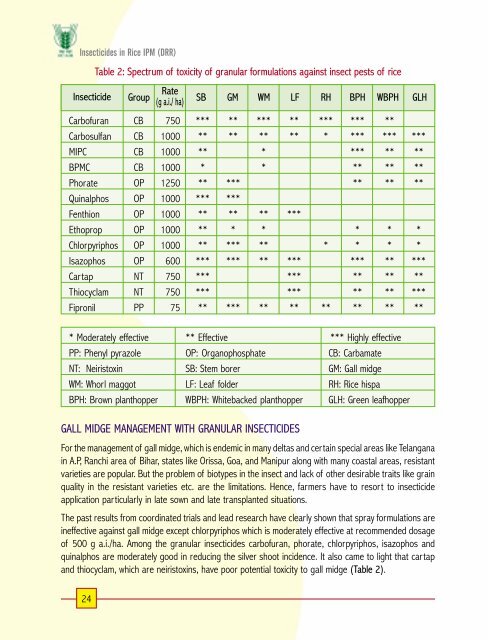priciples of insecticide use in rice ipm
priciples of insecticide use in rice ipm
priciples of insecticide use in rice ipm
Create successful ePaper yourself
Turn your PDF publications into a flip-book with our unique Google optimized e-Paper software.
Insecticides <strong>in</strong> Rice IPM (DRR)<br />
GALL MIDGE MANAGEMENT WITH GRANULAR INSECTICIDES<br />
For the management <strong>of</strong> gall midge, which is endemic <strong>in</strong> many deltas and certa<strong>in</strong> special areas like Telangana<br />
<strong>in</strong> A.P, Ranchi area <strong>of</strong> Bihar, states like Orissa, Goa, and Manipur along with many coastal areas, resistant<br />
varieties are popular. But the problem <strong>of</strong> biotypes <strong>in</strong> the <strong>in</strong>sect and lack <strong>of</strong> other desirable traits like gra<strong>in</strong><br />
quality <strong>in</strong> the resistant varieties etc. are the limitations. Hence, farmers have to resort to <strong><strong>in</strong>secticide</strong><br />
application particularly <strong>in</strong> late sown and late transplanted situations.<br />
The past results from coord<strong>in</strong>ated trials and lead research have clearly shown that spray formulations are<br />
<strong>in</strong>effective aga<strong>in</strong>st gall midge except chlorpyriphos which is moderately effective at recommended dosage<br />
<strong>of</strong> 500 g a.i./ha. Among the granular <strong><strong>in</strong>secticide</strong>s carb<strong>of</strong>uran, phorate, chlorpyriphos, isazophos and<br />
qu<strong>in</strong>alphos are moderately good <strong>in</strong> reduc<strong>in</strong>g the silver shoot <strong>in</strong>cidence. It also came to light that cartap<br />
and thiocyclam, which are neiristox<strong>in</strong>s, have poor potential toxicity to gall midge (Table 2).<br />
24<br />
Table 2: Spectrum <strong>of</strong> toxicity <strong>of</strong> granular formulations aga<strong>in</strong>st <strong>in</strong>sect pests <strong>of</strong> <strong>rice</strong><br />
Insecticide Group<br />
Rate<br />
(g a.i./ ha)<br />
Carb<strong>of</strong>uran CB750 *** ** *** ** *** *** **<br />
Carbosulfan CB1000 ** ** ** ** * *** *** ***<br />
MIPC CB1000 ** * *** ** **<br />
BPMC CB 1000 * * ** ** **<br />
Phorate OP 1250 ** *** ** ** **<br />
Qu<strong>in</strong>alphos OP 1000 *** ***<br />
Fenthion OP 1000 ** ** ** ***<br />
SB GM WM LF RHBPHWBPHGLH<br />
Ethoprop OP 1000 ** * * * * *<br />
Chlorpyriphos OP 1000 ** *** ** * * * *<br />
Isazophos OP 600 *** *** ** *** *** ** ***<br />
Cartap NT 750 *** *** ** ** **<br />
Thiocyclam NT 750 *** *** ** ** ***<br />
Fipronil PP 75 ** *** ** ** ** ** ** **<br />
* Moderately effective ** Effective *** Highly effective<br />
PP: Phenyl pyrazole OP: Organophosphate CB: Carbamate<br />
NT: Neiristox<strong>in</strong> SB: Stem borer GM: Gall midge<br />
WM: Whorl maggot LF: Leaf folder RH: Rice hispa<br />
BPH: Brown planthopper WBPH: Whitebacked planthopper GLH: Green leafhopper











